Text
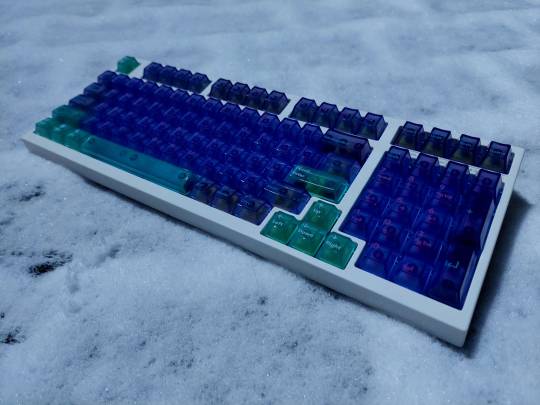
Leopold FC980m
Custom PCB (source)
Aflion Melody and Runner switches
Deadline Studio AirR PC keycaps
Lightblue painted stock aluminium plate
Stock plate-mounted clip-in stabilizers
More under the cut.

This build took well over a year to actually get it to it's current state and it's technically not done yet, considering I still have to tune and lube the stock stabilizers.
Issue number 1 before everything else was getting the cherry mx brown switches out of the old PCB to be able to remove the plate because I didn't want to order a custom plate or go plateless. The solder used on the original PCB has a stupid melting point so not only did I have to dilute the solder with my own that melts at roughly 320°c, but my soldering iron was set to 410°c (or more for specific spots, more on that later). A good chunk of the extracted switches were simply not usable anymore afterwards from being slightly molten. The plate has a few hooks and the PCB has holes for them to hook into, one of which is a PTH (plated through hole) hole that goes to the PCB's ground and the corresponding hook lacks paint and is soldered into this hole. This cursed and damned hook was the reason for a lot of frustration as it took quite literally half an hour (maybe more) to de-solder at 435°c while constantly adding and removing solder to slowly chip away at this literal mountain of solder they used.
My next problem was simply getting the new PCB(s). Back then I was a bit tight on money from expenses out of my other hobbies and various mundane things I needed, so it took a month or two to be able to finally order them. Except JLCPCB, the service that was recommended for this PCB by this keebtalk thread, ran out of the MCUs I needed, so I researched if they had any alternatives, but by the time I read enough of the documentation of various alternatives and found one, that one ended up being out of stock as well. So another couple of months passed basically just waiting.
After ordering, an engineer of JLCPCB contacted me because some of the NPTH (non-plated through hole) holes were too close to each other and would be at risk of breaking while drilling and the best option seemed to be just making them PTH holes, because the hook holes aren't connected to anything and the plate's paint makes it non-conductive anyways so it should be fine. Right?
FORESHADOWING IS A LITERARY DEVI-
I eventually get the new PCBs and of course immediately scratch one of the 5 I ordered (it still works), tested 2 of them and went to work.
Across a couple months (I was preoccupied, blah blah lazy excuses) I slowly chipped away at soldering in the MillMax sockets.
Couldn't have 4 minutes without problems though, now can we?
Trying to install the switches and PCB didn't work because the MillMax sockets add roughly a millimeter of distance between PCB and plate and you can already guess that this doesn't play nice with the plate's hooks. I trimmed off the hooks but left them as little poles for aligning the PCB and so everything would be alright. Right?

I assemble the keyboard fully and plug it in to see... it not working.
I assumed due to the extra millimeter from the hotswap sockets messing with the tolerances, there may be a short to the daughter board, so I took it apart again and taped any contacts and it still didn't work after reassembly. Now I was getting quite annoyed so I took off the top of the casing and tested it like that and surprisingly it worked. Kinda.
As soon as I snapped the top of the case back on, or pressed down on the plate in the bottom left corner, the keyboard would fire A bunch of keys at the same time.
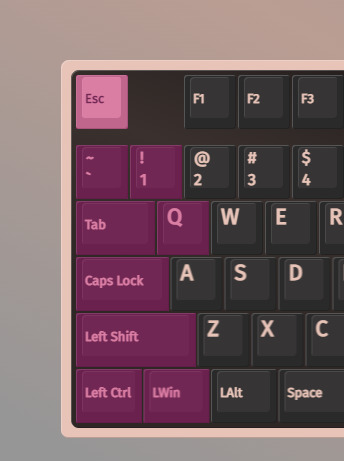
Seeing this set of keys led me to the right path. I double checked this side of the PCB and saw that the hole for the PCB hook next to caps was PTH rather than NPTH and connected to one of the contacts for caps. Remember when I said one of the hooks was connected straight to ground? Or how I had to remove part of the plate hooks, thus removing the paint that prevents it from conducting electricity? Yeah. One strip of tape later and everything is fixed and works perfectly fine.
That's basically it. It was a pain, but it looks, sounds and types nicely.
I'm happy with how it turned out.
2 notes
·
View notes
Text
Nevermind, I'm sleepy. Expect the post in 8-48 hours instead.
The Leopold build is fixed and nearly finished
Expect a post on Saturday.
1 note
·
View note
Text
The Leopold build is fixed and nearly finished
Expect a post on Saturday.
1 note
·
View note
Text
Quick update
After a lot of work, that leopold project is almost done.
The only problem:

All of these keys fire at the same tame when it's fully assembled.
If the top part of the case is off it functions normally, but applying pressure to the lower left quarter of the plate and PCB seems to trigger this issue.
I am yet to find the cause of the issue.
I don't see any potential for shorting caused by metal in the case because the case is plastic and the daughterboard is covered in tape.
With that I disappear to work on projects and play games again.
1 note
·
View note
Text
Still alive, been working on that Leopold FC980m build on and off, will post once that's complete.
0 notes
Text
Well, turns out the MCUs I need are back in stock, so I just HAD to order. Guess this build is getting finished this year after all.
I have this old Leopold FC980m, which is an 1800 layout board, that's been sitting here de-soldered and taken apart for quite some time now.
The plan was (and is) to replace the PCB with a custom one that I can flash QMK/Via onto by following the process in this Keebtalk thread, as well as Millmaxing the new PCB and changing the switches because stock Cherry Browns just aren't that great once you get used to better objectively better switches.
Unfortunately JLCPCB has not had either of the fitting MCUs in stock for quite a long time now, or rather every time I check they're not in stock. This means I've had this project sitting here taken apart collecting dust for nearly a year at this point.
2 notes
·
View notes
Text
I have this old Leopold FC980m, which is an 1800 layout board, that's been sitting here de-soldered and taken apart for quite some time now.
The plan was (and is) to replace the PCB with a custom one that I can flash QMK/Via onto by following the process in this Keebtalk thread, as well as Millmaxing the new PCB and changing the switches because stock Cherry Browns just aren't that great once you get used to better objectively better switches.
Unfortunately JLCPCB has not had either of the fitting MCUs in stock for quite a long time now, or rather every time I check they're not in stock. This means I've had this project sitting here taken apart collecting dust for nearly a year at this point.
2 notes
·
View notes
Text
I think there is a certain charm to having a keyboard with a very uneven sound profile. Not in an insane way like alternating between clicky and tactile switches, mind, but rather in a way where every keystroke sounds slightly different than the next. It's like a mechanical melody played on a non-musical instrument.
Very even sound profiles are also nice, but I feel like they can often sound boring and bland after a while if they are too flat.
sorry about missing another weekend post
2 notes
·
View notes
Text
Another short-ish post this week, just about something I've noticed with some factory lubed switches.
Some switches like WS reds and the old V1 of the Aflion Tropical Waters switches seem to have their lube become... off, at least if left alone for long enough and in an environment that is a bit warmer than usual, like being left in the sun or a really warm room.
That particular brand of lube starts to have some of it (or a broken down oil?) liquefy and leak out of the switches. I noticed it on my Tropical Waters V1s a few months ago, being surprised to find small drops of oily lube on the bottom of their plastic container. The same thing happened to my WS reds a few days ago when I checked them to see what switches I want to talk about next.
One sign of switches that seem to have this issue is a rather unpleasant smell when keeping them in mostly sealed plastic containers and taking a sniff after opening the lid a few hours or days later. The Aflion switches didn't have this at first but developed the smell after a couple months.
An unfortunate side effect this seems to have is a degraded quality of the lube when this happens, at least on the WS reds, making them a bit scratchy and unfit for a review or similar, which is a bit unfortunate.
2 notes
·
View notes
Text

Small post this week.
I actually got a chance to take a picture in the dark of the luciola switches when they've charged up with enough light.
There is no backlighting here, these are glow in the dark switches!
52 notes
·
View notes
Text
Aflion Melody & Runner Switches
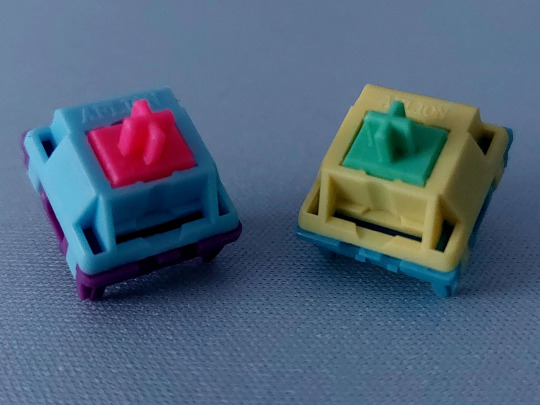
These rather colorful tactile switches I got in a pack of 90 from Keygem in Germany for 0.65 euro a pop and they are for sure the type of switch you look at and cry that it's not edible by most people's standards.
Let's kick it off with the basics:
Medium/strong tactility
60g/70g two-stage spring
Polycarbonate top housing
Nylon bottom housing
POM long-pole stem
3.5mm travel
Manufactured by Aflion
While they are sold as different switches, they differ mainly in their colorway, spring weight, and tactility, particularly the purple, pink and blue melody switches being lighter than the blue, green and yellow runners in weight and tactility.
Aflion is known by some in the community for their excellent factory lube job on the tropical waters switches, and they've certainly hit the nail on the head with this pair of switches as well. You buy 'em, get 'em in the mail, pop 'em in and enjoy. Smooth as butter.
The housings fit well and don't need films, and stem wobble is limited mostly to some very slight east/west directional wobble, so a good choice for people who really dislike or are sensitive to wobbly switches.
Another thing that's to be noted is that these do sound as nice as they look and feel. With a rich, rather deep tone on bottom out and a mellow reset, these are a joy to use.


Looking on the inside you can see a healthy amount of lube on the stems, as well as some grease on the bottom of the springs, similar to how Gazzew does the springs on their switches, to prevent pinging and crunching. Though I suppose in hindsight it's a little hard to see the lube on those pictures, but blame my camera for that.
Overall these switches are well worth their price and they are available from a number of different stores worldwide with decent availability as long as stock lasts, so you most likely won't need to import them from anywhere too far away, at least for now.
2 notes
·
View notes
Text
BBN (BuiltByNim) Linear Switch x Ciel65

Because I missed last Saturdays post and was being a bit lazy until now y'all get a twofer from me today with both a build and a switch post in one!
I'll get into the meat of the switch below the cut, but I got a 90 pack of these curious fellas as part of mykeyboard.eu's surprise switches round 5 offering for just 17 euro, which is a steal compared to the normal 6.81 euro price tag on a pack of 10.
Before I start rambling on any longer, here's the specifics on the Ciel65 Build you're seeing in the picture at the top:
Stock BBN Linear switches
No stabs (build is mostly for show and testing on alphas)
CannonCaps Earl Grey Lavender PBT keycaps
Aluminium plate

With that out of the way, let's dive a little deeper into the specifics of the BBN Linears starting with their rough specs:
63.6g two-stage gold-plated spring
Nylon top housing
Polycarbonate bottom housing
POM long-pole stem
Manufactured by Tecsee
Now, these are fairly common materials that are being used here, but what I find particularly interesting is the deviation from the norm of using using transparent polycarbonate as the material for the bottom housing when it's usually used for the top housing. This makes me want to toy around with different plate and keycap materials to see what sounds I can get out of them.

When I got them, considering I got them as part of what's essentially a switch lootbox, I didn't know what the specs of these were, nor if they came factory lubed or dry and from initial playing around with them I was sure they were very lightly factory lubed from the rather slick push feel and lack of any pinging from the leaf and spring. Now imagine my surprise when I opened them up to a completely dry stem and spring!
The stem tolerances are fairly tight with a slight bit of wobble and the housing fits really tightly into the alu plate of the Ciel65, so much so that my thumbs are a little sore from trying to get them into the board.
I quite enjoy these, even if the flat sound profile isn't 100% my thing and I bet you could get them smoother with either a light lube job or some breaking-in. Having the option for rather clear RGB lighting due to the clear bottom housing and plain white top housing for those people who love their light machines is a neat bonus. If you like this kind of linear switch then they should be worth the full price.
20 notes
·
View notes
Text
Didn't get to write something up this week.
Hopefully gonna post something on Wednesday to make up for it.
0 notes
Text
Off-schedule bonus post/reblog:
Because I decided to do some light peripheral cleaning (dust, hair, etc.) today you actually get a picture of how the switches are arranged!


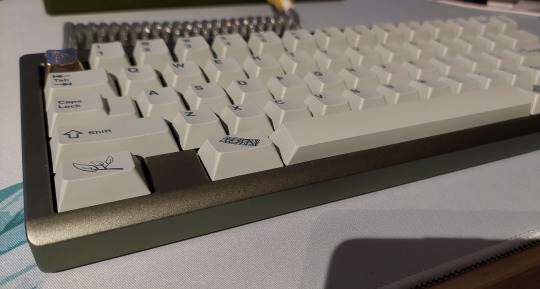

Parallel Limited Snake 60%
Lubed JWK Snake, Gateron Cap Yellow V2 and a few other switches.
Owlstabs stabilizers (space uses a TX r3 wire).
NovelKeys Cherry Sage keycaps and RAMA x Delftware artisan.
13 notes
·
View notes
Text


Owlab Voice Mini macropad.
Aflion Runner switches.
NovelKeys Sage keycaps.
TX R3 Stabilizer.
Case, plate and encoder wheel are all aluminium.
17 notes
·
View notes
Text
Wisteria B-Stock

I bought these switches for roughly 0.26 Euro per from the fellas at All Caps in Australia while getting other stuff (like the deskmat in the picture) to make international shipping worth it.
Buying international to get stuff that isn't available locally is exciting, but I can't help but feel a bit bad every time I do order from the US, Australia, or China.
Let's get into the basics:
These switches are long-pole linears manufactured by Meirun, a Chinese manufacturer for various types of switches, not just keyboard switches. The materials used overall aren't anything to blow your mind with a POM stem, PC top and nylon bottom. This leads to a familiar but nice snappy, loud and bright bottom out sound, and a more toned down and in comparison rather quiet reset sound. Travel distance is 3.4mm and the springs for the A-stock are (according to specs) relatively standard 62g and 15mm steel(?) springs.
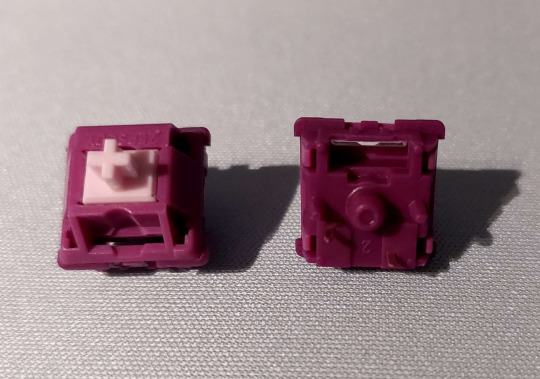
With that we already have the first issue, which was expected as it's listed on the product page as well: the springs have different weights and lengths between most of the switches. I have found there being mostly 3 categories: As advertised, lighter and very light.
The very light variation feeling nearly like a 45-50g spring.
The length of the springs varies by roughly +-1.5mm but doesn't seem to be in relation to their weight.
Now of course this is easily fixed if you just have springs on hand to swap them out, no biggie, but fixing an over-lubed switch is not as easy if you don't have fancy stuff or techniques to get that excess lube out of the nooks and crannies of the bottom housing. The switches are hand-lubed, consistently lubed, mind, but in my opinion it's a bit excessive.
There also seems to be some oddity with roughly 15% of the stems, where the pole is slightly longer, maybe .2mm, leading to shorter travel and a somewhat different, louder sound on bottom out.
Another problem I've found that a scary amount of switches were unusually scratchy, which got me curious so I opened some up and found that it's caused by 2 separate issues:
First off a more easily fixed issue is some random debris in there that might be small bits of plastic, maybe fabric? It's most likely from when they were lubed and while annoying, it's by far the lesser evil.
The moment I went "yikes" out loud was when I found some of the stems to have an issue where I found them to have small bits sticking out, mostly on the backside and the sliders, as well as on some bits that don't really matter for performance.
(There are also some weird dark blue-ish spots that only affect the looks of the stem)

The good news is that you can probably sand those bits down and polish them afterwards and that would fix them, bad news, I don't think most people would want to put in the time and effort to do that.
Alternatively, you might be able to use a break-in machine instead of polishing them after sanding, but I currently cannot test that.
Out of the 100 I bought, I counted 70 to be usable but requiring a spring swap to be consistent, the rest having either debris/dirt in them or having the mentioned busted stems. This doesn't hurt too bad considering they were dirt cheap and obviously no shade at the vendor as it was B-stock after-all and I knew what I was getting myself into.
The switches that are usable feel nice and smooth but due to the generous amount of lube the bottom out noise is dampened a lot and it sounds a bit sad honestly. The few switches I got with the longer poles on the other hand don't seem to suffer from it too much and sound incredible. If I took the time and re-lubed them proper I bet they'd all sound like that, but that is for another day.
The bottom line is that the B-stock is, as advertised, a gamble. The switches that are usable mostly feel and sound great, but those that don't, require anywhere between a little and a lot of effort to fix. If you get these, you will most likely want to buy A-stock, or plenty of spares and some springs if you buy B-stock, as well as being cautious about buying these on the aftermarket.
I would also like to say that while this might seem overly negative, these are not bad switches; they are quite good linears in fact. It just happens that the bad ones of the bunch are quite bad indeed and that linears don't have a whole lot to talk about.
If I can get my hands on A-stock of the Wisteria switches I will keep y'all posted, most likely as a reblog to this post.
1 note
·
View note
